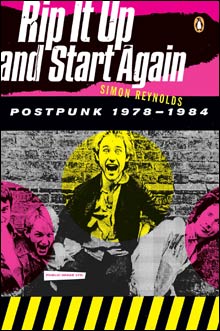 Some postpunk aficionados consider Mission of Burma to be the American equivalent to Wire. Experimenting with song structure and sound texture with a similarly dry, methodical approach, the Boston band loved to play games with form and expectation. Unlike Wire or Talking Heads, MoB weren’t an art school band as such, but they were definitely arty (as songs such as “Max Ernst” and the Magritte-inspired “This Is Not a Photograph” indicate). Their conceptual bent came from a different kind of high-art background, classical music college.
Some postpunk aficionados consider Mission of Burma to be the American equivalent to Wire. Experimenting with song structure and sound texture with a similarly dry, methodical approach, the Boston band loved to play games with form and expectation. Unlike Wire or Talking Heads, MoB weren’t an art school band as such, but they were definitely arty (as songs such as “Max Ernst” and the Magritte-inspired “This Is Not a Photograph” indicate). Their conceptual bent came from a different kind of high-art background, classical music college.
In the midseventies, guitarist/vocalist Roger Miller had started a composition major at CalArts — “writing very complex piano scores and pieces for percussion trios,” he says — only to quit because “academia didn’t suit me.” By early 1978, Miller had moved to Boston, his plan being to do experimental work involving tape loops and prepared piano. Instead, he joined a New Wave band called Moving Parts. He hit it off with the group’s bassist Clint Conley, and the pair, keen to do more aggressive music, split off in 1979, recruiting drummer Peter Prescott, who’s previously played in the art rock band the Molls (in which the lead instrument was bassoon!), to form Mission of Burma.
When punk rock came along, Miller had been “just blown away by these people who could barely play guitar. I could play complex pieces by Schoenberg, but things like the Sex Pistols meant more to me than complexity.” But in Mission of Burma, the complexity slowly crept back in. “I think we’re just a closet prog-rock act that happened during punk,” laughs Conley. “We were attracted to the velocity and volume of punk, but at the same time Roger and I were both really attracted to composition.” As the raw blasting power of punk gave way to postpunk’s unlikely amalgams of minimalism and sophistication — Wire, Gang of Four, the No Wave movement, Pere Ubu, all admired by Mission of Burma — Miller’s training suddenly became relevant. The result was “avant-garde music you can shake your fist to,” as one critic famously put it. Live, Mission of Burma were an art attack, playing their music with dispassionate ferocity and at earsplitting volume.
Where Conley tended to write and sing the more melodic, shout-along tunes such as “Academy Fight Song” (MoB’s debut single) and “That’s When I Reach for My Revolver,” Miller’s tunes resembled partially dismantled anthems. The sheer noise assault of the MoB live experience seemed to signify rock, but their songs generally frustrated the simple-rock out impulse. This combination of visceral and cerebral meant that Mission of Burma were “sort of an acquired taste,” Conley told one observer. “We heard it over and over again throughout our career that people would see us the first time and it just wouldn’t make any sense at all. Listening to our live tapes, I know what they’re talking about. Sometimes it’s just like chewing gravel or a visit to the dentist’s office.” Miller recalls playing Danceteria in New York “with four hundred people in the room, and by the third song there’d be six left!” Says Conley, “I always felt like we were just interrupting people! They’d be dancing to the latest sounds from England, and we’d come on and make a big mess, and then they’d go back to their fun.”